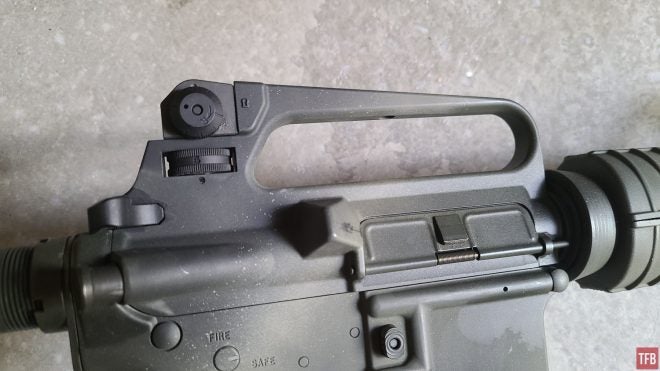The carry handle. Love it or hate it, it’s an iconic feature of the AR-15. In recent years there has been a resurgence in their popularity. Unfortunately, this has led to some misunderstandings and incorrect advertising. So let’s take a look at the common models and what sets them apart.
More Retro Gun Articles @ TFB:
- New Retro Lower Receiver From Unbranded AR
- [SHOT 2022] The Retro Roundup
- Brownells Introduces California Compliant RETRO Rifles
- Brownells Retro 4X Carry Handle Scope Now Shipping
- [SHOT 2019] BROWNELLS Goes Retro with BRN-180 and BRN-Proto
The A1
This is the original carry handle. It takes its name from the M-16A1, which is where it was most commonly found. But it was also found on famous models like the XM-177. The A1 has a windage adjustable rear sight. The elevation is adjusted in the front sight. The sight aperture is L-shaped, with two apertures available. One is for close range, and one is for long range. Both apertures are small, and they sit at slightly different heights to compensate for drop.
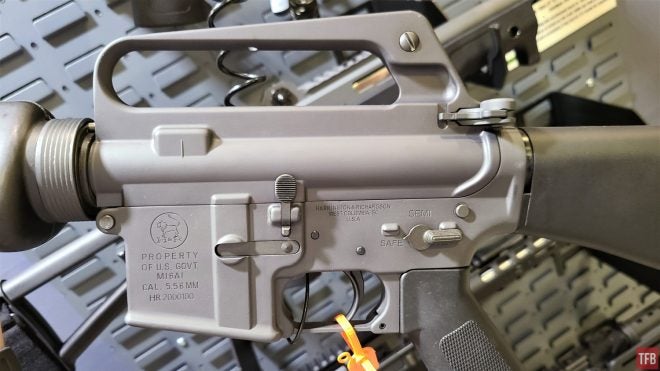
H&R-branded M-16A1 from PSA at SHOT 2022
The rear sight requires a tool to adjust. Now, “tool” may be too strong of a word because the point of a .223 bullet also works. But it is easier to do with a small screwdriver or similar implement. This tool is only necessary to depress a detent so that the wheel can be adjusted.
There are variants within the A1 family. The most popular is known as the C7 from its use in the Canadian C7 family of rifles. It blends an A1 carry handle with the brass deflector from the A2 (discussed below). This upper has been in great demand because it was prominently used on the Colt 733 rifles in the classic movie Heat.
Identifying an A1 upper is easy. Just look for an elevation adjustment wheel on the carry handle. If there isn’t one, odds are good it is an A1 or similar variant. The rear sight windage adjustment looks like a small wheel with holes for a detent.
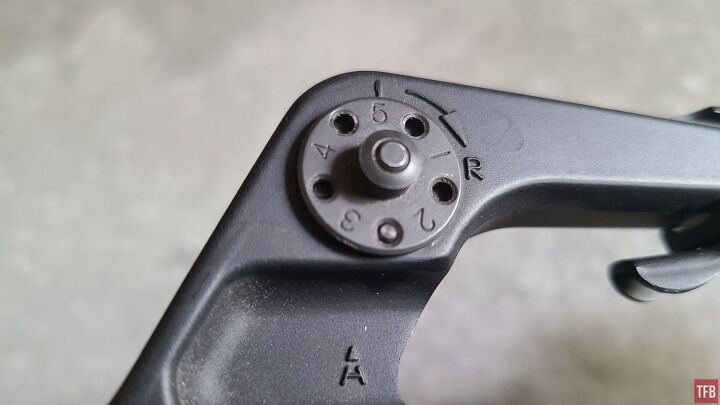
The A1 windage adjustment requires a tool to depress a small detent (located between the “2” and “3” in this image)
The A2
The A2 upper added some additional complexity and functionality. Most notably, the rear sight includes finger-adjustable windage and elevation knobs. These have been the source of much controversy, with some suggesting that they are too complex for a fighting rifle. The apertures also changed. A large “low light” setting is paired with a small standard aperture used for most situations. Both apertures sit at the same level and shoot the same zero, unlike the A1.
It is very easy to identify A2 uppers. The windage and elevation knobs are quite visible. Also, a large, triangular brass deflector was added immediately behind the ejection port. This same brass deflector is used on the C7 upper.
Prominent numbering is visible on the elevation wheel. The front and rear sights are elevation-adjustable. Once the front sight elevation is set, it is left alone, and the rear sight is then used. The zero setting is at “3/8” which is the 300-meter battle zero. Setting such as “4” for 400 meters and “5” for 500 meters are visible on the side and top of the elevation wheel. One full revolution ends back on the “3/8” setting which is the 800-meter setting. These numbers will not be accurate with all types of ammunition, but they do provide at least a rough idea.

Prominent windage and elevation controls make it easy to identify the A2 upper, along with the brass deflector (bottom right)
Personally, I disagree with the common complaints about the A2 sights. “Losing your zero” is easy to prevent. The elevation wheel bottoms out at or near the zero. Windage adjustments can be marked with a paint pen, or verified with the small hash marks below the aperture. Zero settings can also be written down and taped to the stock or stored in the pistol grip as an additional backup.
The A2 sights also allow zeroes with different ammunition to be stored and used. For example, moving from M193 to M855 ammo could cause a hypothetical zero shift of three clicks up, and two clicks right. That information can be stored on a note, or marked with a different color paint pen.
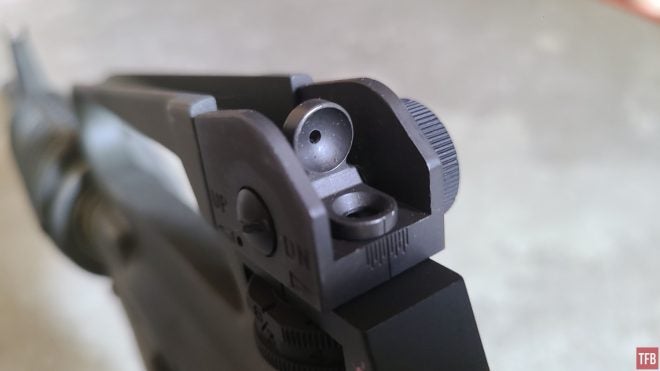
The A2 features different aperture sizes (also, note the index mark on the large aperture and the hash marks showing adjustments from the center)

Paint pen marks verifying the windage zero
The A3/A4
We have arrived at the most commonly mislabeled carry handle, the detachable A3/A4. We will simply call it the A3. This is the most common model because it fits a standard flat top upper. And there are millions of flat top uppers out there. Functionally, the A3 is very close to an A2. The obvious difference is that it can be removed. The other difference is much more minute, with the elevation battle zero setting labeled “3/6” instead of “3/8.”
The A3 is easy to identify. Two large thumbscrews protrude from the left side. A small gap can also be seen where the A3 grips onto the Picatinny rail. The “window” inside the carry handle is much smaller as well.

A3 upper with distinctive gap and the smaller window
Optics Mounting
The A1, A2, and A3/A4 all feature a small hole in the top of the carry handle for optics mounting. Initially, this was used for the fixed 4x scope sold by Colt and copied by others. Today, various other optics are carry handle compatible. Trijicon ACOGs, Meprolight and Trijicon fiber optic reflex sights, and Primary Arms prism scopes all have purpose-built carry handle mounts.
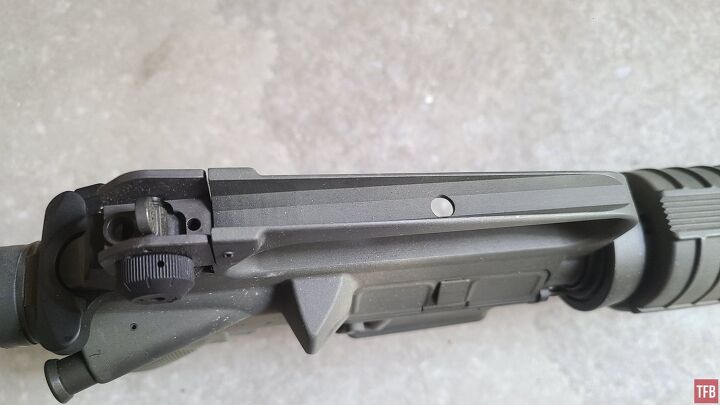
The optics mounting hole is present on A1, A2, and A3 uppers

Brownells XM-177 shown with the Brownells 4x Retro optic affixedSpecial adapters can be used to mount other optics. Some sit on top of the carry handle, while others project forward of the carry handle and drop down. These “gooseneck” mounts place a red dot further forward, but can also allow for a co-witness with the irons.

Trijicon reflex sight on a gooseneck mount to co-witness with the iron sights
Most of these mounting options preserve the view of the iron sights. Generally, a trough or hole is machined into the mount. The view of the sights may be partially obstructed but are typically still usable.

Carry handle Picatinny rail
Conclusion
Cloning up a classic military M-16 variant or movie gun requires the right upper. But if you aren’t going for a specific clone look, the different features may be appealing depending on the intended use. Users who want to “set it and forget it” will prefer the A1. The A2, properly understood, can provide much more adjustability for those wanting match-grade accuracy. The A3 is best for the carry handle curious because it can be removed easily and replaced with a boring, modern optic. Whichever you choose, a real AR guy has to own at least one carry handle.

Tony’s Customs at SHOT 2022, with an A2 (top), a C7 (middle), and an A1 (bottom) upper on display
We are committed to finding, researching, and recommending the best products. We earn commissions from purchases you make using the retail links in our product reviews. Learn more about how this works.
 Your Privacy Choices
Your Privacy Choices
